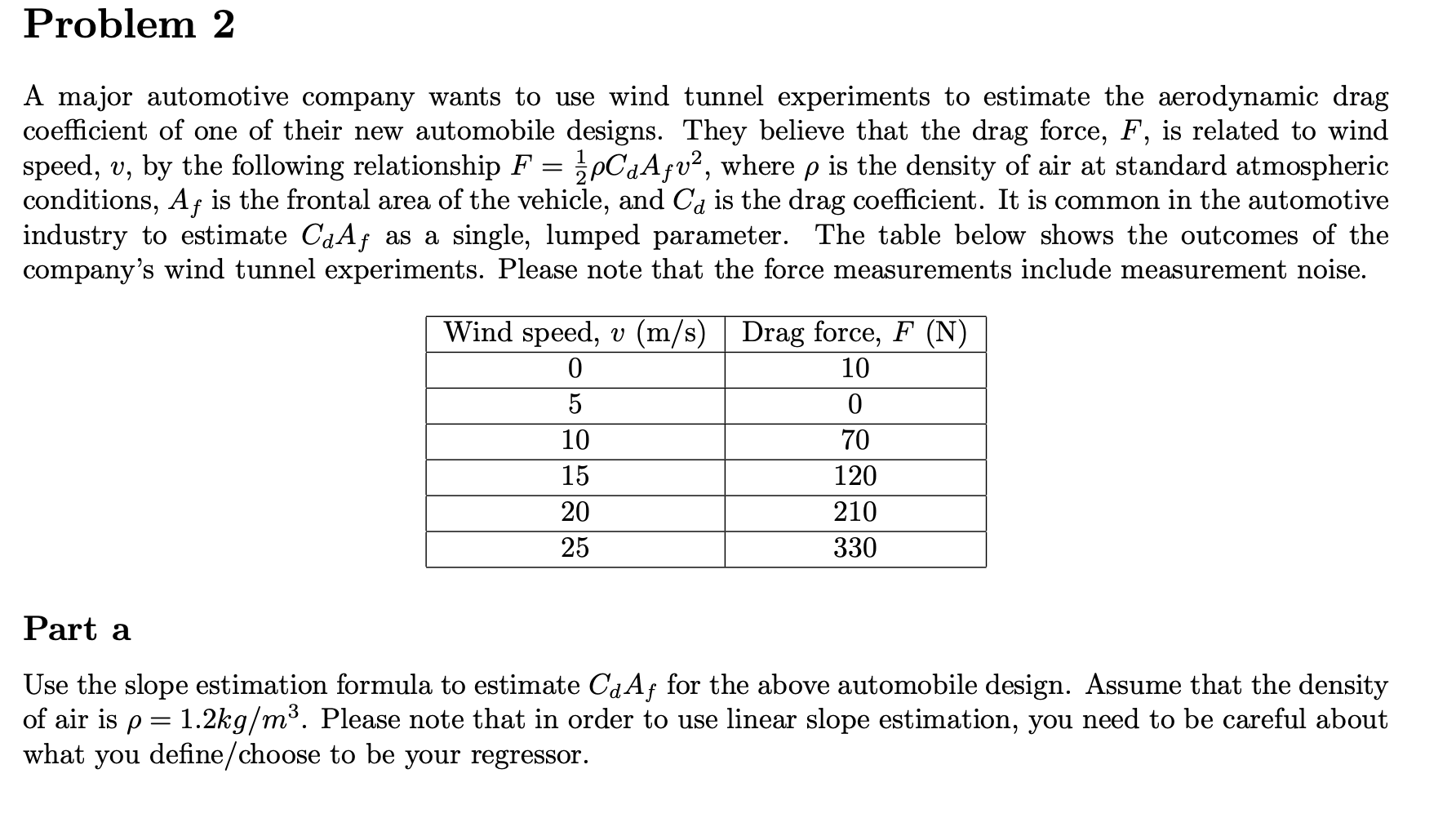Problem 2 A major automotive company wants to use wind tunnel experiments to estimate the aerodynamic drag coefficient of one of their new automobile designs. They believe that the drag force, F, is related to wind speed, v, by the following relationship F = pCaAƒv², where p is the density of air at standard atmospheric conditions, Af is the frontal area of the vehicle, and Ca is the drag coefficient. It is common in the automotive industry to estimate CaAf as a single, lumped parameter. The table below shows the outcomes of the company's wind tunnel experiments. Please note that the force measurements include measurement noise. Wind speed, v (m/s) | Drag force, F (N) 10 5 10 70 15 120 20 210 25 330 Part a Use the slope estimation formula to estimate CaAf for the above automobile design. Assume that the density of air is p = 1.2kg/m³. Please note that in order to use linear slope estimation, you need to be careful about what you define/choose to be your regressor. Part b Refer to Problem 2, including Part (a). Compute the coefficient of determination, or "r squared", for the estimation problem you solved in Part (a). Given this coefficient of determination, are you comfortable with the accuracy of your curve fit? Why or why not?
Problem 2 A major automotive company wants to use wind tunnel experiments to estimate the aerodynamic drag coefficient of one of their new automobile designs. They believe that the drag force, F, is related to wind speed, v, by the following relationship F = pCaAƒv², where p is the density of air at standard atmospheric conditions, Af is the frontal area of the vehicle, and Ca is the drag coefficient. It is common in the automotive industry to estimate CaAf as a single, lumped parameter. The table below shows the outcomes of the company's wind tunnel experiments. Please note that the force measurements include measurement noise. Wind speed, v (m/s) | Drag force, F (N) 10 5 10 70 15 120 20 210 25 330 Part a Use the slope estimation formula to estimate CaAf for the above automobile design. Assume that the density of air is p = 1.2kg/m³. Please note that in order to use linear slope estimation, you need to be careful about what you define/choose to be your regressor. Part b Refer to Problem 2, including Part (a). Compute the coefficient of determination, or "r squared", for the estimation problem you solved in Part (a). Given this coefficient of determination, are you comfortable with the accuracy of your curve fit? Why or why not?
Principles of Heat Transfer (Activate Learning with these NEW titles from Engineering!)
8th Edition
ISBN:9781305387102
Author:Kreith, Frank; Manglik, Raj M.
Publisher:Kreith, Frank; Manglik, Raj M.
Chapter5: Analysis Of Convection Heat Transfer
Section: Chapter Questions
Problem 5.13P: 5.13 The torque due to the frictional resistance of the oil film between a rotating shaft and its...
Related questions
Question

Transcribed Image Text:Problem 2
A major automotive company wants to use wind tunnel experiments to estimate the aerodynamic drag
coefficient of one of their new automobile designs. They believe that the drag force, F, is related to wind
speed, v, by the following relationship F = pCaAƒv², where p is the density of air at standard atmospheric
conditions, Af is the frontal area of the vehicle, and Ca is the drag coefficient. It is common in the automotive
industry to estimate CaAf as a single, lumped parameter. The table below shows the outcomes of the
company's wind tunnel experiments. Please note that the force measurements include measurement noise.
Wind speed, v (m/s) | Drag force, F (N)
10
5
10
70
15
120
20
210
25
330
Part a
Use the slope estimation formula to estimate CaAf for the above automobile design. Assume that the density
of air is p = 1.2kg/m³. Please note that in order to use linear slope estimation, you need to be careful about
what you define/choose to be your regressor.

Transcribed Image Text:Part b
Refer to Problem 2, including Part (a). Compute the coefficient of determination, or "r squared", for the
estimation problem you solved in Part (a). Given this coefficient of determination, are you comfortable with
the accuracy of your curve fit? Why or why not?
Expert Solution
This question has been solved!
Explore an expertly crafted, step-by-step solution for a thorough understanding of key concepts.
This is a popular solution!
Trending now
This is a popular solution!
Step by step
Solved in 3 steps with 9 images

Recommended textbooks for you

Principles of Heat Transfer (Activate Learning wi…
Mechanical Engineering
ISBN:
9781305387102
Author:
Kreith, Frank; Manglik, Raj M.
Publisher:
Cengage Learning

Principles of Heat Transfer (Activate Learning wi…
Mechanical Engineering
ISBN:
9781305387102
Author:
Kreith, Frank; Manglik, Raj M.
Publisher:
Cengage Learning